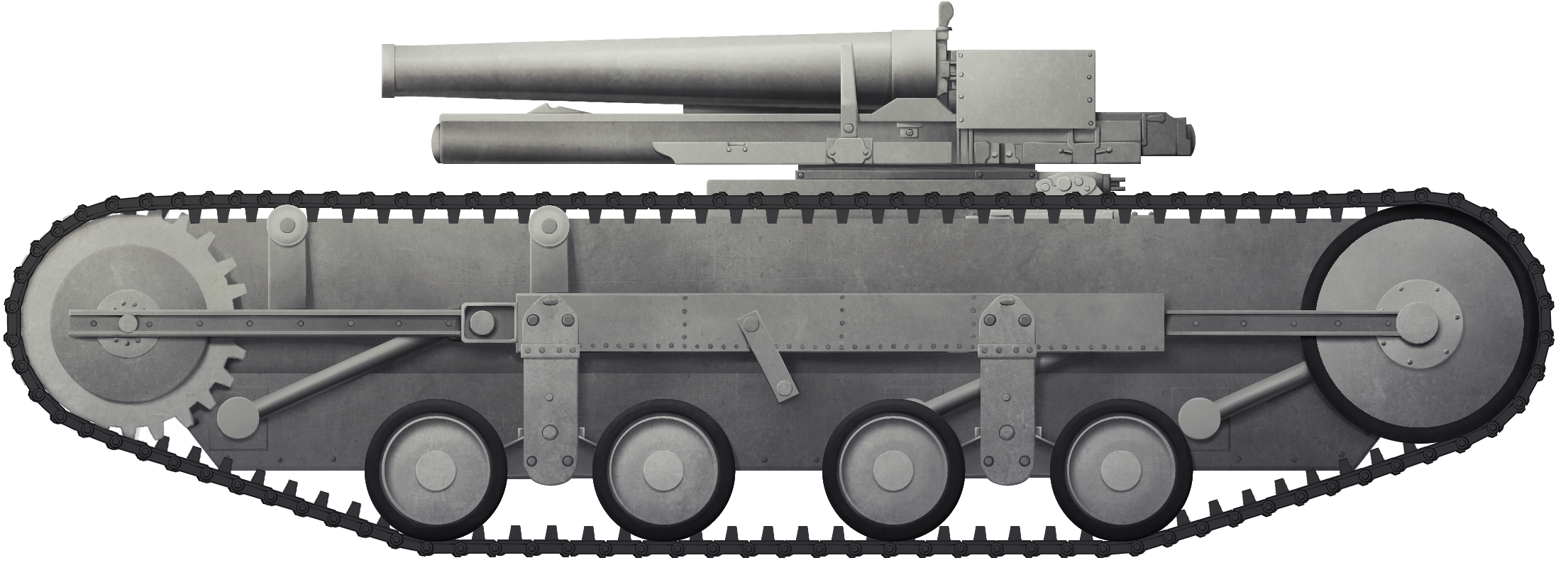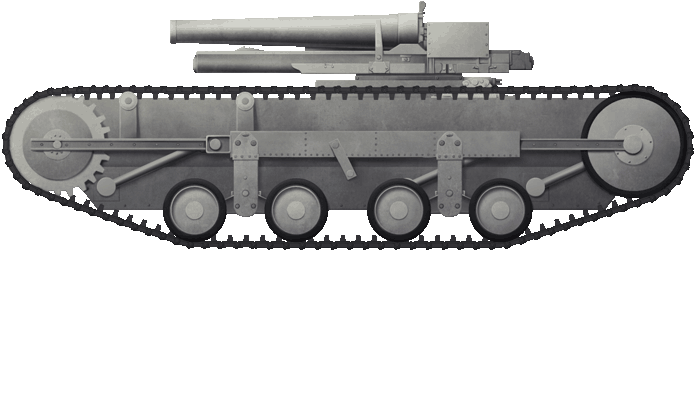 Kingdom of Italy (1921)
Kingdom of Italy (1921)
Self-Propelled Gun – 1 Built
Mountainous northern Italy was treacherous tank country. Any war fought there on that terrain would be difficult. As well suited to defense as mountains were, any force which could deploy armor there, especially if they could also deploy some mobile artillery, would have a significant advantage. Combine this need with the late 1920’s assessment that the doctrine for new warfare should be highly mobile tactically making full use of light tanks combined with strategic mobility and Italy had a clear requirement for a vehicle able to achieve both goals.
Early work had involved testing the British Carden-Loyd Mark VI light tank as well as the Mark V* light tank. Both had some advantages such as their small size and mobility but also some disadvantages in terms of the arrangement of automotive components.

The Carden-Loyd Mark VI entered service with Italy fitted with a single machine gun as the CV29. The Mark V* was not assigned an official Italian service number but served as an inspiration for Ansaldo’s design for a 65 mm gun armed vehicle.
The Entry of Moto-Guzzi
The Italian firm Società Anonima Moto Guzzi, better known as just ‘Moto Guzzi’, is world famous for motorcycles and is Italy’s oldest motorcycle producer, having started in 1921. They even developed a completely enclosed armored motorcycle mounting a heavy machine gun. Of far more military use though they also worked on a fully tracked vehicle design. This design was a significant departure from anything seen before. It had two versions. The first was just a tractor which served as a test bed and the second was based on the same vehicle, but mounting a gun.

Structure
The basic structure of both vehicles was the same as the chassis were the same consisting of two independent track units mounted on arms and driven by an engine in the front. The driver and another crew member would sit at the back to command, drive and service the gun. The cabin seen in the test bed is a roll cage for protection from rolling over and it is unknown whether it was intended to be a permanent feature on either vehicle. Certainly, some sort of protection for the crew would have been required for the Semovente (a self propelled gun for infantry support) should it have been built.
Suspension
The suspension was very unusual and consisted of two tracks completely independent of each other consisting of four wheels on a supporting bar, along with an idler and drive sprocket all suspended on three rotatable arms. As one track moves down, these arms rotated, ensuring that the body of the vehicle remains horizontal and the tracks move at different heights. The arrangement was unlike anything before in Italy and had the significant advantage of allowing movement across the side of a steep slope. The drawing from Moto-Guzzi suggests a side slope of approximately 45 degrees. Drive appears to be provided via the front sprocket as per the prototype vehicle. However, the exact arrangements of the fastenings for the wheels is likely to have differed on the envisaged production vehicle from the test bed.
The drawing of the Semovente shows four road wheels and the test bed also has four wheels but each wheel is paired so as to leave a gap down the centre for the track guide. A large external supporting bar ran from the front sprocket to the rear idler wheel on which were mounted small track support wheels.
Engine
Moto-Guzzi made a lot of motorcycles for the Italian Army and had a lot of experience in small high powered engines but it is not known what engine was used in the design. The cylindrical object at the front of the test bed is unknown but appears to be either the exhaust or possibly a fuel tank, which would have to have been completely rearranged on a production vehicle to permit the gun to be used.



Armament
The Moto Guzzi, as a tractor, would (amongst other duties) be used for towing light guns. As a semovente, it would mount the 65mm Model 1913 mountain gun. This gun was made by the Royal Arsenal in Naples and was 17 calibers long. It was an ideal gun for use in the mountains as it could be broken down easily into 5 loads for transport. It fired the 65mm x 172R rounds just under 5kg in weight and ammunition for the gun was mainly high explosive, but a specific shrapnel shell was also available. Later, an armour piercing (AP) and also a hollow charge shell were available for it.

Conclusion
The Semovente Moto-Guzzi was a very advanced design for the time. A design ideally suited to the rigours and demands of mountain warfare and carrying a weapon specifically designed for the job. It was not to be, however. The Moto-Guzzi design, either for work as a tractor or as a semovente, was discontinued by 1930. The Italians would have to look elsewhere for a suitable gun carrier to meet their unusual requirements.

Illustration of the Semovente Moto-Guzzi produced by Andrei Kirushkin, funded by our Patreon Campaign.
Specifications |
|
| Crew | 2 |
| Armament | 65mm L/17 Model 1913 mountain gun |
Sources
Italie1939-45.com
Italian Artillery of WWII, Ralph Riccio
Iron Arm: The Mechanization of Mussolini’s Army, 1920-1940, John Sweet
Gli Autoveicoli da Combattimento Dell’Esercito Italiano V.2, Pignato and Cappellano
Italian Armoured Vehicles of World War Two, Nicola Pignato
La Meccanizzazione dell’Esercito Italiano, Ceva and Curami
motoguzzi.com

